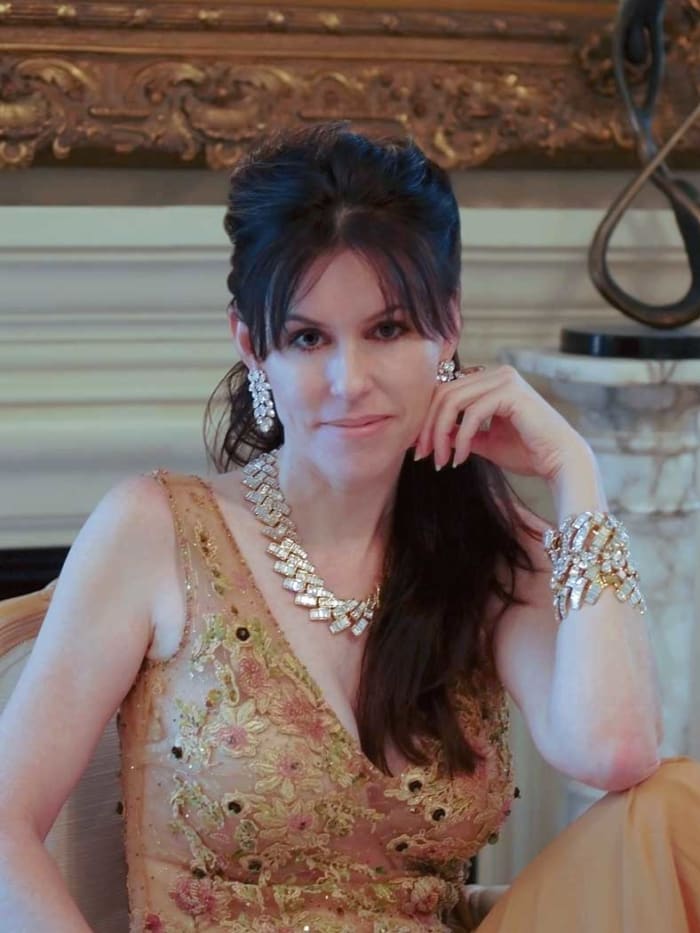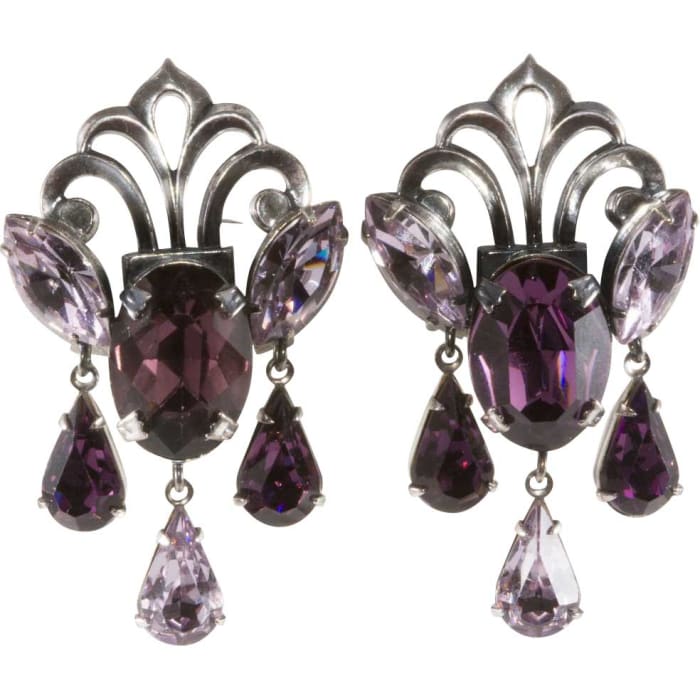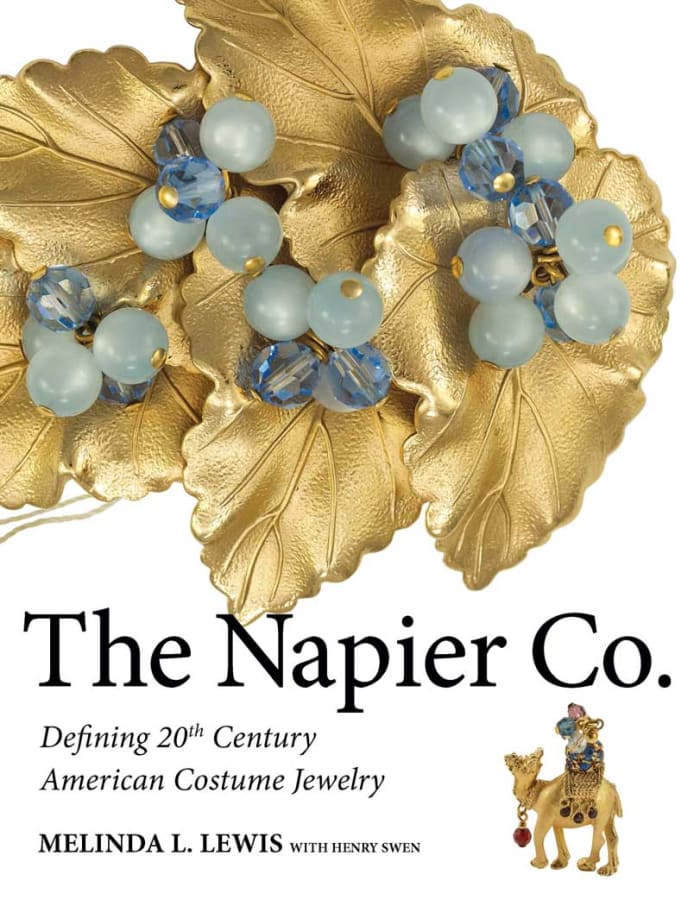#Love #1950s #Napier #Jewelry
Like most collectors, I own several items I don’t ever intend to sell. Among my treasured cache are more Napier jewelry designs from the 1950s than any other timeframe. This includes one of my very first antique shop jewelry purchases in the 1990s, an outstanding Napier silver plated Maltese cross necklace with powder blue rhinestones. It’s one of my “what’s not to love” pieces.
When Melinda L. Lewis – my Costume Jewelry Collectors Int’l partner and dear friend – wrote The Napier Co. several years ago, I couldn’t wait to see what she had discovered about the firm’s jewelry from my favorite period. I’m pleased to share some of that research with you as a follow-up to James Napier’s honorable mention as a costume jewelry influencer as well as some of my own observations about Napier’s stylish designs from the 1950s.
Doing It All
Napier celebrated its 75th and 80th anniversaries as a manufacturing jewelry company in the 1950s. James Napier led the firm and Frederick Rettenmeyer, who had also been with the company for decades at this point, headed up the design team as a hands-on vice president. Rettenmeyer employed two designers, Warren Dontigney and Eugene E. Bertoli. Working in collaboration, this talented trio designed some of Napier’s most fascinating pieces. Many of these are featured in The Napier Co.
Napier is one of the rare jewelry manufacturers that never adhered to one style. The business was, in essence, a “complete resource for fashion jewelry.” Other companies like Miriam Haskell are known for faux pearls and antique gold-tone plating. Monet is known for metalwork. Eisenberg is known for using an abundance of rhinestones. “Napier did them all, and in many cases better than the specialists in their fields,” a former Napier employee told Lewis for her tome on the business.
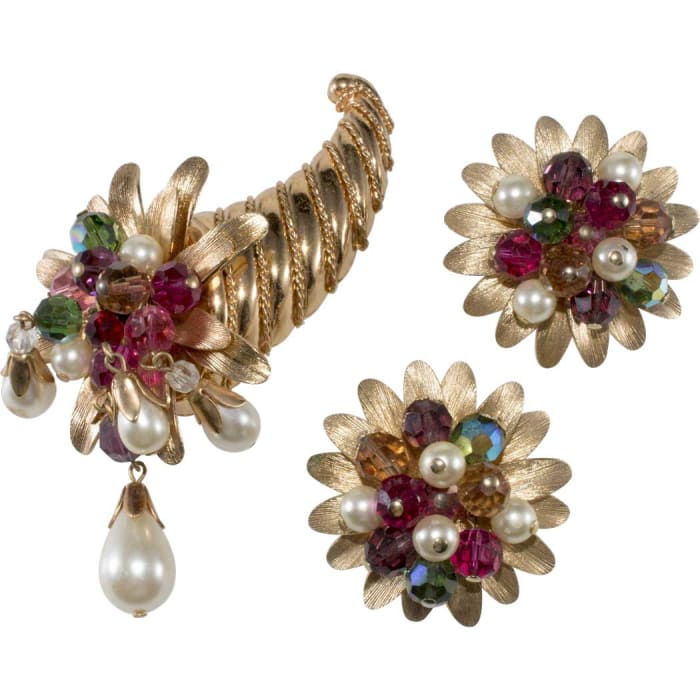
Napier cornucopia brooch and earring set with gold plated Florentine finish, late 1950s. Value: $100-$150.
Courtesy Jay B. Siegel
From colored glass cabochons and rhinestones, which Napier described as “foiled back faceted crystal stones,” set in elaborate metalwork to pieces decorated with faux pearls or crystal beads, the embellishments incorporated into their mid-century designs vary widely. Many different metal finishes were used as well including heavy silver plating, brushed gold-tone looks, and polished metals. A very limited amount of sterling silver was employed as well, and those pieces are marked Napier Sterling. Napier also used a variety of manufacturing techniques including casting and hand manipulation, sometimes combining methods to finish a piece.
More on the Jewelry
Beyond the wide variety of styles, one aspect that makes Napier’s 1950s jewelry so appealing is the quality. Many of the designs were sold in fine jewelry stores or in boutique settings and the quantity of each style made was often relatively low. This explains why collectors find fewer of these pieces offered for sale in the secondary marketplace in comparison to mass-marketed Napier jewelry made decades later.
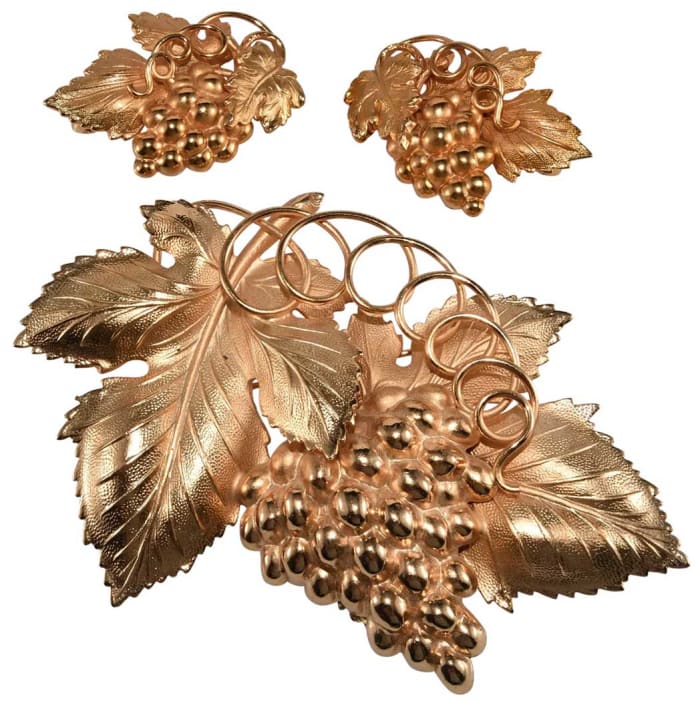
Napier “Danish Grape Leaf” brooch and earrings set, 1959, one of Napier’s best-selling designs during the period. Value: $75-$125.
Courtesy Jay B. Siegel
This exclusive jewelry is extremely well-made making it very durable for modern wear. Most of the metal work, stones, and other components have held up beautifully, although pieces stored haphazardly may show more wear than others. The unique, eye-catching designs often serve as conversation starters as well.
Among the most desirable Napier jewelry pieces from this era is a bracelet scenic elephant panels from a line called “Endangered Species.” This piece, known as the “Mamie Eisenhower Bracelet” was presented to the first lady in 1953. Although original publicity touted that only two were produced, it was one of 25 examples made. Eight have been accounted for, according to Lewis. The sale of the related collection was meant to raise funds for animal preservation groups although it was not as well-received as company executives had anticipated. All pieces in these lines, including pins and necklaces, are hard to find today.
Napier’s charm bracelet designs from the ‘50s have also been popular with collectors for quite some time. One of Napier’s best-sellers was the “Tropicana” bracelet laden with pearlized Lucite, or Moonglow, fruits is one of these desirable pieces. Others have a mash-up of charm styles including those with Asian themes like Chinese characters or beads and metal findings forming Japanese lanterns. Interestingly, some “Buddha” and foiled art glass charm bracelets are marked Germany. This is a very rare exception as the vast majority of this company’s pieces left the factory marked Napier.
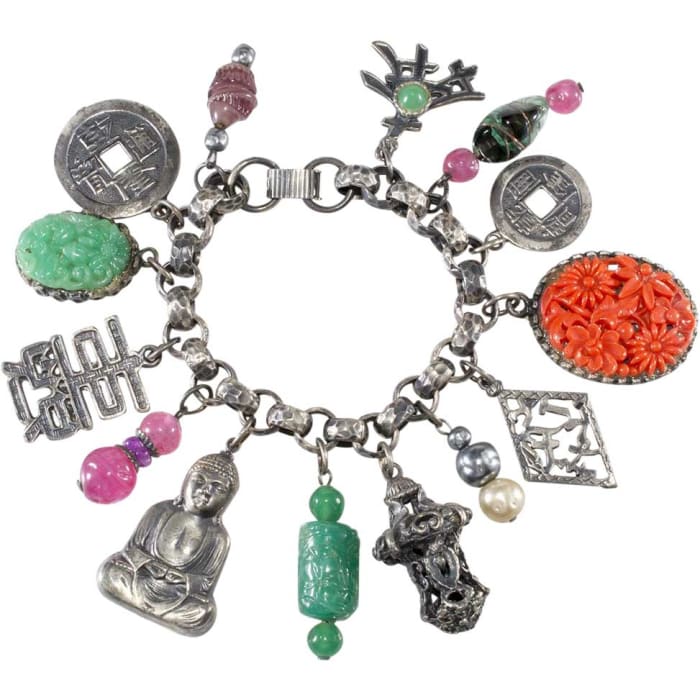
Napier “Buddha” charm bracelet, 1950s. This is one of the charm bracelet styles sometimes marked “Germany.” Value: $175-$225.
Jay B. Siegel
Suites of jewelry produced by Napier made during this period are also prized by collectors. In fact, over the past few years, values have been rising for the more uncommon designs in sets or parures with multiple matching pieces. When they come in original Napier satin-lined hinged boxes, that makes them even more desirable. Even so, compared to some other high-profile brands of vintage costume jewelry, many mid-century Napier designs remain moderately priced.
The Celebrity Connection
Napier fervently used star power to promote their jewelry in the 1950s. The firm developed its own marketing materials as well as relying on celebrity photos published in magazines and “gossip columns” to spur interest in their wares.
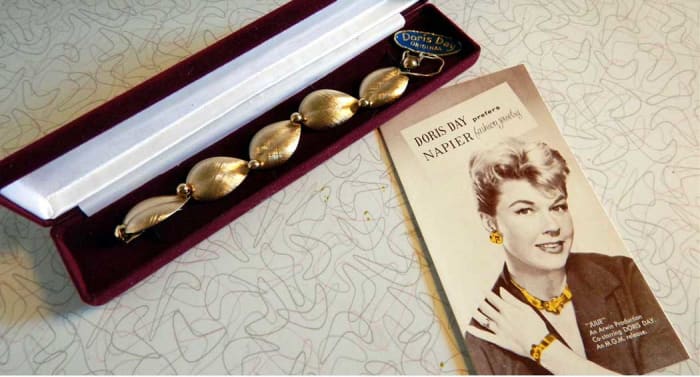
Napier used celebrities to promote its jewelry, including actress and singer Doris Day
as a spokesperson in 1955.
Image courtesy Melinda L. Lewis
Marketing booklets published by Napier like “Stars and Jewels” and “Mr. Fashion” promoted some of their lines. They featured well-known celebrities like television personality Steve Allen with his wife Jane Meadows wearing Napier jewelry. Jewelry was also provided to contestants crowned as Miss America in the mid-1950s and they were frequently photographed wearing those pieces, some of which appeared in their promo materials.
Recognizing the clout an admired face could have on a brand, Napier hired actress and singer Doris Day as a spokesperson in 1955. She signed a two-year contract for a “Doris Day Jewelry” line. These designs were sold with hang tags that included her name although the jewelry was simply marked Napier. Day appeared in many ads, including those for local retailers, wearing the Napier pieces from the resulting collections.
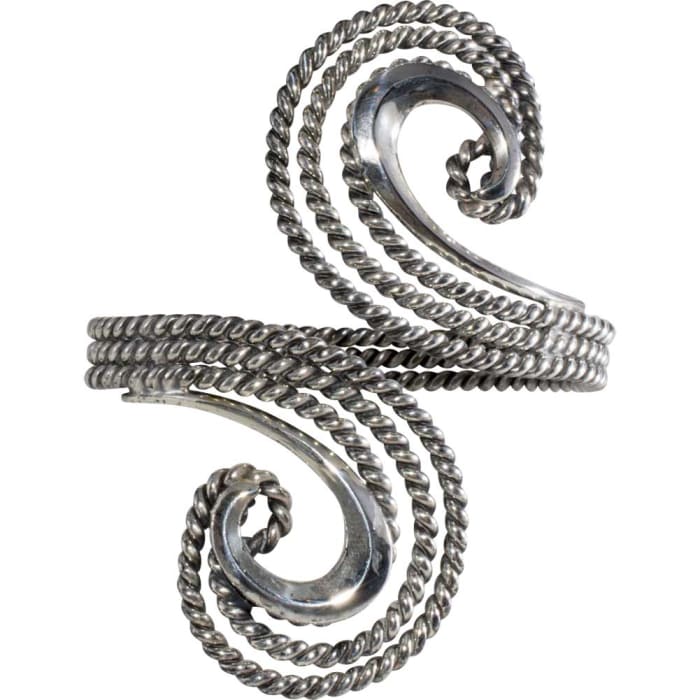
Napier silver plated cuff bracelet from the “Doris Day Jewelry” collection, mid-1950s. Value: $75-$100.
Courtesy Jay B. Siegel
Perhaps no other star was featured as prominently, however, as Marilyn Monroe. She was photographed wearing a pair of amazing dangle basket earrings measuring 3 5/8″ long appearing on the covers of “MovieLand” and “Movies” magazines in 1954.
Learning More
A great point of departure for learning about this company is NapierBook.com. Lewis shares more information about Napier jewelry there as well as offering her book for purchase on the site.
With more than 1,000 pages dedicated to the brand ranging from the late 1800s through 2000, along with general jewelry and fashion history, The Napier Co. makes a great addition to a jewelry reference library. And while I may personally be partial to the 1950s, the jewelry from the ‘60s included in this reference is also quite impressive. Many pieces from my own collection were photographed and included in the book, which was quite an honor for me as a jewelry enthusiast. My keeper Maltese cross necklace, in fact, is featured on page 220 of the book.
You May Also Like:
How to Pick Rhinestone Jewelry That Sells

